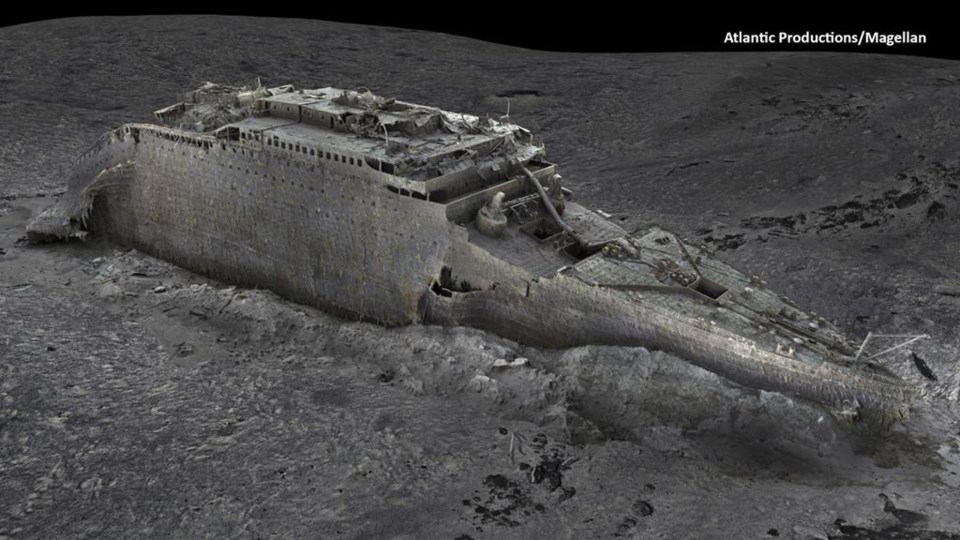Five explorers eager to view the underwater wreck of the Titanic remained lost at sea Tuesday as a massive search operation continued in the North Atlantic.
OceanGate Expeditions’ underwater submersible, dubbed Titan, was headed more than 700 kilometres off the coast of St. John’s, N.L., when it lost contact with its support ship.
The trip was just the latest excursion to a haunted site that has lured adventure-seekers since its discovery in 1985.
A look at the expedition:
WHY VISIT THE TITANIC?
The deadly sinking of the massive ocean liner in 1912 has captured the fascination of historians, scientists and average observers alike. More than a century later, few don’t know it struck an iceberg on its doomed maiden voyage from Southampton, England to New York and pulled more than 1,500 people to a watery grave.
Don Lynch, official historian of the Titanic Historical Society, visited the site twice in 2001, and said from California that the Titanic is “part of our history and folklore. It’s not just any shipwreck.”
Toronto-based doctor and deep-sea explorer Joe MacInnis, 86, agreed as he mused on why some adventure tourists are willing to pay US$250,000 to see it up close.
“As young kids growing up, we all listened to that story and it intrigued us because it has so many deep and profound lessons about courage and about cowardice,” said MacInnis, who dove to the site three times in 1987, 1991 and 2005.
“The question that it asks of all of us is: How would you behave if that was happening to you? If the ship was sinking beneath you, how would you respond to this?”
HOW DOES A SUBMERSIBLE DIFFER FROM A SUBMARINE?
While a submarine is a fully autonomous craft, a submersible must be launched by a vessel on the water’s surface, a platform, shore team or sometimes a larger submarine. In this case, the Titan was supported by a former Canadian Coast Guard icebreaking ship known as the Polar Prince.
A submarine is also able to renew its own power and breathing air, while a submersible has limited reserves. A specifications sheet on the OceanGate website says the Titan can sustain a crew of five people for 96 hours.
The vessel began its descent Sunday morning. That suggests the oxygen supply would last to Thursday morning at the latest.
WHAT’S IT LIKE INSIDE THE TITAN?
OceanGate says the Titan is made from carbon fibre and titanium. Inside it’s just 6.7m x 2.8m x 2.5m — about the length of a short school bus.
MacInnis, who was not familiar with the Titan, said anyone willing to dive to the Titanic must also withstand tight quarters in vessels that reach such depths.
“You’ve got to be a bit claustrophilic, you've got to like small places when you dive in the Russian sub or the French sub," he said by comparison.
"Inside the sub, there's a kind of nice red glow light, or it can be fully lit, or it can be dark, depending on what's going on. But the beauty, of course, is having a lot of light on the outside shining (outwards).”
WHAT SAFETY MEASURES ARE ABOARD?
The OceanGate website says the Titan is equipped with a real-time hull health monitoring system that can assess the integrity of the hull during a dive. It uses acoustic sensors and strain gauges to analyze the effects of changing pressure on the craft as it dives ever deeper, and monitors the integrity of the structure.
MacInnis said the possibility of implosion due to a compromised hull is one of three devastating catastrophes he worries about in such dives. The other two are fire and entanglement.
While each is a grim scenario, they do not have to end in disaster, he said.
"You anticipate those possible hazards and you design your way around them. And then you practise and you practise and you practise and you do the best you can to control them."
WHAT’S IT LIKE DEEP IN THE OCEAN?
The remains of the Titanic sit 3,800 metres deep in the Atlantic and while it's been photographed and mapped, there's nothing like seeing it in person, said MacInnis.
The journey down is a descent through a "universe of darkness," while flashing bioluminescent lights — a natural glow emitted by marine species — guide the way.
"The trip down is like going to another planet,” he said. “And then when you see it — oh my God, the scale of it is what is so impressive. The size of the anchors and also the scale of the damage."
The ocean liner split in two as it cracked and sank, settling on the ocean floor with debris strewn between each chunk — thousands of artifacts that spilled from the great ship when it broke apart.
“It's an extraordinary experience to go down there and look, and look with reverence at what has happened, and an appreciation for the forces of the ocean," said MacInnis.
"The wind, waves, the cold, the current, the corrosion and the pressures that bend steel.”
-- With files from Morgan Lowrie in Montreal.
This report by The Canadian Press was first published June 20, 2023.
Cassandra Szklarski, The Canadian Press



